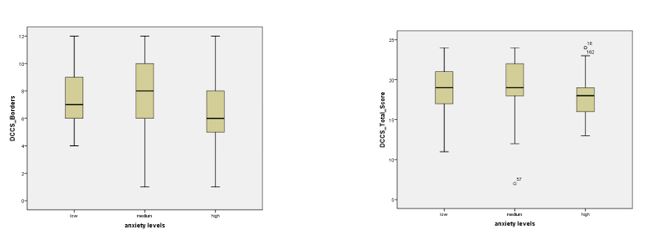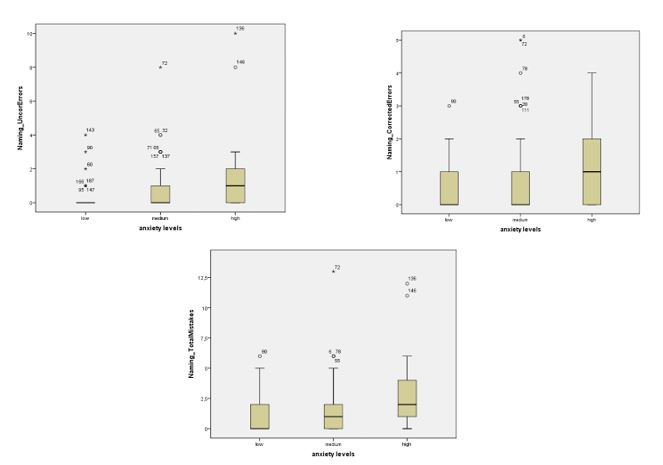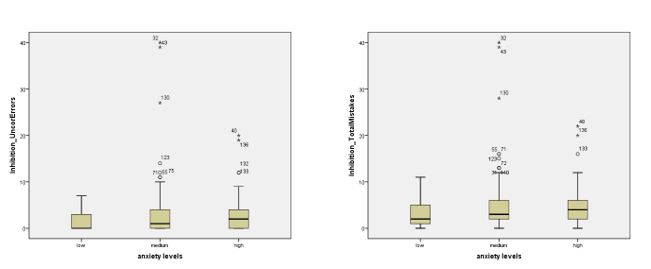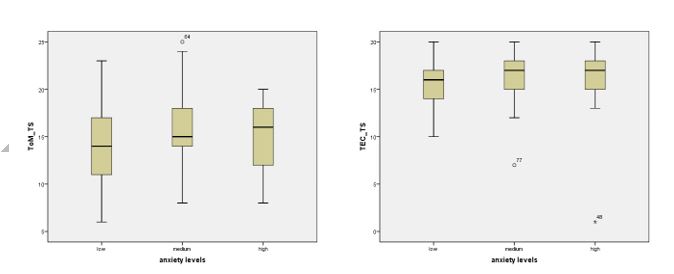Abstract
This article examines the relationship between anxiety level and cognitive and emotional development in older preschool children. The study involved 207 children aged 5-6 years (Me = 5.6 years) attending a senior group in a Moscow kindergarten (108 boys and 99 girls). As a result of the cluster analysis, three groups of children were identified: with the low (20.3%), medium (61.8%) and high (17.9%) anxiety levels. We paid special attention to the analysis of the performance on the methods diagnosing executive functions (switching, inhibition and working memory) by children with different anxiety levels. The data obtained testify to the negative effect high anxiety has on the performance of tasks dealing with cognitive flexibility and inhibitory control whereas no connection was established between anxiety and working memory (both auditory and visual). Besides, the data we have obtained indicate a nonlinear connection between the anxiety level, theory of mind development and the understanding of emotions in the preschool age. Thus, this research have shown that the preschooler’s anxiety level is a significant internal factor associated with the development of both executive functions and emotional intelligence. In this regard, it is possible to assume that working with anxiety can help harmonize the development of the child and prepare for school.
Keywords: Preschool ageanxietyexecutive functionstheory of mind
Introduction
Among the significant problems of modern society is the psychological well-being of children. Numerous approaches to solving this issue tend to be based on analyzing the intra-family atmosphere, the social environment, the quality of education, etc. Nevertheless, the internal factors that impact children’s mental health and their harmonious development have not been studied well enough. One of such internal factors which are powerful regulators of a child's mental and subsequently physical health can be considered to be the emotional sphere that regulates children’s behavior and activities.
One of the signs of a child's internal unhappiness is its heightened anxiety. Anxiety adversely affects all areas of its life: study, communication with peers, personal development and health (Hadwin & Field, 2010). The high anxiety level is one of the preconditions for early school disadaptation, so it is important consider and study this feature of the child early in its preschool childhood. At the same time, a total lack of anxiety is also a predictor of the fact that the child’s development is not the most optimal at this age as it often indicates insufficient development of the preschooler’s emotional and personal sphere.
Anxiety
Psychological literature provides different descriptions of the concept in question which boils down to two definitions: anxiety as an emotional state or as a stable personal trait or temperament (Gazelle & Rubin, 2010).
As a state, anxiety is an emotional discomfort experience associated with expectations of some trouble, the premonition of an imminent danger. Anxiety has mostly a negative and disorganizing effect on children’s performance in the preschool, junior school age and adolescence, while in later periods it can have a mobilizing impact. The anxiety one feels in relation to a particular situation depends on one’s negative emotional experience in this and similar situations and indicates that one is emotionally not adjusted to them strongly enough.
On the other hand, anxiety as a personal entity has a complex structure which includes cognitive (anxious thoughts), emotional (negative experiences) and behavioral (avoiding behavior) levels. The emergence and reinforcement of anxiety are associated with a child’s main age-related needs remaining unsatisfied. With preschool children and younger schoolchildren anxiety results from the frustration of their need for security and protection by their immediate environment. It does not become a stable personal entity until adolescence, before it high anxiety in children is traditionally associated with disruptive relations with their close adults (Chorpita & Barlow, 1998; McLeod et al., 2007; Volbrecht & Goldsmith, 2010). We based our studies on this understanding of anxiety.
Domestic and foreign psychologists distinguish the following features in older preschool age children with intensive anxiety:
• Such children have a relatively high level of learning ability, notwithstanding this, their caregiver may consider the child to be incapable or not capable enough of learning.
• These preschoolers cannot identify the main problem in their work and instead of focusing on it they try to control all the elements of the task all at once.
• An anxious child gives up other attempts if it fails to cope with the task at one go; blaming its failure on the lack of every sort of ability rather than on its inability to solve a specific problem.
Such peculiarities in the child's behavior hinder its work in the developing classes at the kindergarten which may affect negatively the development of its cognitive skills and abilities. In addition, in line with the attentional control theory, intensely anxious people require additional resources to carry out their cognitive activities in order to overcome their experiences of anxiety (Eysenck et al., 2007). Therefore, their activities can be disrupted: sometimes this manifests itself in efficacy (accuracy in fulfilling the task assigned) but it is reflected mostly in the amount of efforts they spend on doing the task, which can be estimated in terms of time costs, speed of response or the amount of mental strain. Thus, it can be said that there is a link between anxiety and the group of cognitive skills foreign psychologists call executive functions.
Executive functions and anxiety.
In modern psychology, executive functions are understood to mean a group of cognitive skills that provide solution to targeted tasks and adaptive behavior in new situations. The most popular current model is Miyake’s model of executive functions (Miyake et al., 2010), which comprises three main components: working memory, cognitive flexibility and inhibitory control. These components are related to each other, but they can also be viewed as being independent, separate from each other, which is why this model came to be known as "unity-with-diversity". Despite being initially based on the results obtained in adults, the possibility of using this model to describe development in childhood was also confirmed in the works by foreign and domestic researchers (Almazova et al., 2016; Cheie et al., 2014; Sobkin et al., 2016).
An increasing number of studies show the connection that exists between anxiety and cognitive regulation, especially when performing tasks requiring highly developed processes of inhibition and shifting (Berggren & Derakshan, 2013; Eysenck et al., 2007; Mocan et al., 2014). There is also evidence that working memory mediates the effect of anxiety on pre-school and primary school children’s academic achievements (Owens et al., 2008). Most of them being devoted to adult study, the data about the effect of anxiety on executive functions processes, however, are quite contradictory and few in number (Hadwin & Field, 2010; Mueller et al., 2012; Owens et al., 2008).
It is also important to take into account the fact that as a personality trait anxiety is bound to affect the development of a child’s emotional and personal sphere. It is often attributed to the domain of relationships with other people because it has a profound influence on the child's behavior and development of his communicative skills. Many studies in the field of clinical psychology consider anxiety in conjunction with such behavioral disorders as hyperactivity, aggressive behavior, social phobia and other negative effects on communication problems with the child’s environment (Gazelle & Rubin, 2010; Muris et al., 2008). Therefore, anxiety is traditionally associated with problems in interaction, but its connection with theory of mind and emotional intelligence development in the preschool age has practically not been studied.
Problem Statement
Most of the existing research on anxiety aims to study the causes and mechanisms of anxiety development and reinforcement as a personality trait whereas studies showing its impact on the development of children in preschool age are relatively few.
We considered senior preschool age children because at this age they are developing cognitively and emotionally at a rapid pace as they are being prepared for school education, on the efficacy of which their future success will depend so much.
Research Questions
We suggested that a high level of anxiety disrupts the child's activity, which complicates its harmonious executive functions development.
Conversely, children with low anxiety tend to be "out of touch with the situation" and not considerate enough of their own emotional experiences and other people’s feelings.
Purpose of the Study
In connection with this, the purpose of our study was to examine the relationship between anxiety and the cognitive and emotional development in older preschool children..
Research Methods
Most of the methods used in the study are NEPSY-II subtests (Korkman, 1999; Korkman et al., 2007), aimed at assessing the mental development of children aged 3-16 years.
The anxiety level in children was measured with the help of the Anxiety Test (Amen et al., 2002). It allows one to identify anxiety in relation to a number of communicative situations typical for preschoolers. This test is designed for children aged 4-7 years and consists of 14 pictures which exist in two versions: one for girls and the other for boys.
To diagnose the level of all executive functions development components the following methods were used:
-
The first was the Inhibition subtest consisting of two samples - Naming and Inhibition which recorded the number of errors and the amount of time it took the child to complete the test (Korkman et al., 2007; Sobkin et al., 2016).
-
The second was the DCCS task (Zelazo, 2006). These methods gradually increase the task complexity to get the child to shift different executive functions components. Comparison of the performance on individual tasks helps to identify which of the executive functions components are still underdeveloped in the subject (Almazova et al., 2016).
-
To study working memory, two NEPSY-II subtests were used: Memory for Designs measuring the development level of the child's visual memory and visual-spatial orientation; and Sentences Repetition measuring the development level of the child's verbal memory (Almazova et al., 2016; Korkman et al., 2007).
To diagnose emotional development we used two methods:
-
The first, Theory of Mind, is a NEPSY-II subtest and aims to directly diagnose the development of various mental model components: the ability to understand other people’s phrases of speech, intentions, thoughts and feelings, the ability to distinguish between real and imaginary planes of reality as well as the understanding of false beliefs.
-
The second method, Test of Emotion Comprehension (TEC) [17], [18] is aimed at studying children’s ability to understand the emotions of other people in different situations.
Findings
The sample and procedure of the study
The study sample consisted of 207 children aged 5-6 years (Me = 5.6 years) attending the senior group in a Moscow kindergarten. The sample included 108 boys and 99 girls. This study was conducted in the 2015-2016 school year. All tasks were carried out individually, in a quiet room. Three meetings each 15-20 minutes long were organized for each child.
Results of the cluster analysis
Based on the distribution of the results of the method for measuring preschool children’s anxiety level (frequency tables), were divided into 3 groups:
1) Preschool children with a low anxiety level (20.3%, 42 children);
2) Preschool children with an average anxiety level (61.8%, 128 children);
3) Preschool children with a high anxiety level (17.9%, 37 children).
We considered specific features of fulfilling tasks to determine the level of EF development in preschool children from different groups (in terms of anxiety). Table.
Note that the results of the methods diagnosing visual and audio-verbal memory were significantly different in children with different levels of anxiety.
Next, considering only those parameters for which the differences in the Kruskal-Wallis criterion were obtained, we checked them one pair after another as to which groups in particular display significant differences (the Mann-Whitney test for two independent samples). In addition, box plots were constructed for all EF aspects which obtained significant differences (see Figure



As a result of pairwise comparison, the following results were obtained:
1) There is no significant difference in the estimates for the parameters under consideration between pre-school children with low and medium anxiety.
2) Estimates for all of the parameters considered, except for Sorting with Borders (DCCS, Borders), differ significantly (U - from 417.0 to 514.5, p - from 0.03 to 0.055) in preschool children with high and low anxiety (given all the significant differences obtained, the success of performance is lower in children with high anxiety).
3) Estimates for all of the parameters considered, except for "Inhibition, corrected errors" (Inhibiton, Corrected Errors) and "Inhibition, Total errors" (Inhibition, Total Errors), differ significantly (U - from 1561.0 to 1702.5, p - from 0.02 Up to 0.023) in preschool children with average and high anxiety (given all the significant differences obtained, task performance is lower in children with high anxiety).
Thus, the anxiety level is not related to the successful performance of tasks on working memory (auditory and visual). Preschool children with a high level of anxiety do cognitive flexibility tasks significantly worse than others. In addition, their performance on shifting tasks is most successful in preschool children with an average level of anxiety, and that on Inhibition in children with a low level of anxiety.
Further, features of emotional sphere development (understanding of emotions and the model of the mental) were analyzed for children with different levels of anxiety. Table
By using the Mann-Whitney criterion for pairs of independent samples, we checked which of the groups display significant differences in the level of emotional development. Figure

As a result of pairwise comparison, we found that the results for both methods were significantly higher in preschool children with an average level of anxiety than in those with low anxiety (U = 1400.5, p = 0.046 for Theory of mind, U = 927.5, p = 0.010 for the understanding of emotions). The difference between preschoolers with low and high anxiety can be traced to the score of the understanding of emotions at the level of the trend (U = 322.5, p = 0.071): respondents with a high level of anxiety understand emotions better at the level of trends. There are no significant differences in the assessment of preschool children with an average and high level of anxiety.
Conclusion
Thus, the study showed that there is a link between anxiety and EF: preschool children with a high level of anxiety perform switching tasks significantly worse than others whereas children with an average level of anxiety cope with them most successfully. In addition, children with a low level of anxiety coped with constraining control tasks best of all which was manifest in the least number of their errors. This agrees well with the data available in the literature on the negative impact of anxiety experiences on children’s activities: a child is worried that he can make a mistake, and he needs more mental effort to cope with negative emotions which tells on his activities (Eysenck et al., 2007; Mocan et al, 2014).
Since executive functions develop actively in the older preschool age and these tasks require special mental efforts, the effect of a high level of anxiety is particularly noticeable (Cheie et al., 2014).
The study results also found the anxiety level not to be directly related to performance on auditory and visual working memory tasks. The available studies show that the connection between anxiety and this EF component can be indirect, and it therefore requires additional more detailed research (Owens et al., 2008).
The analysis of the relationship between anxiety and children’s performance on emotional intelligence tasks showed that the average anxiety level proves to be optimal for the preschooler’s emotional development. On the other hand, a low level of anxiety makes it difficult to understand emotions, and in a way hinders the development of his ability to take another’s position and look at the situation from a different angle. Thus, it can be assumed that the low anxiety level also manifests emotional ill-being or shows a lack of ToM development in preschool children.
Undoubtedly, anxiety is an indicator of the child's emotional comfort. Besides this, we have shown that the preschooler’s anxiety level is a significant internal factor associated with the development of both regulatory and emotional spheres. In this regard, we believe it is possible to assume that working with anxiety can help harmonize the development of the child in general and, in particular, the development of such an important and decisive construct as executive functions.
Acknowledgments
The work was supported by grant of the Russian Scientific Fund # 16-18-00032
References
- Almazova, О.V., Bukhalenkova, D.А., & Veraksa, А.N. (2016). The voluntariness in the preschool age: a comparative analysis of various approaches and diagnostic tools. National Psychological Journal, 4(24), 14–22. doi:
- Amen V., Temml R., & Dorca M. (2002). Anxiety test: App. to the book. “Practical work on psychology.” SPb.: Rech, 2002. P. 15.
- Berggren, N., & Derakshan, N. (2013). Attentional control deficits in trait anxiety: Why you see them and why you don’t. Biological Psychology, 92(3), 440–446.
- Cheie, L., Veraksa, A.N., Zinchenko, Y.P., Gorovaya A. & Visu-Petra, L. (2014). A cross-cultural investigation of inhibitory control, generative fluency, and anxiety symptoms in Romanian and Russian preschoolers. Child Neuropsychology: A Journal on Normal and Abnormal Development in Childhood and Adolescence, DOI:
- Chorpita, B. F., & Barlow, D. H. (1998). The development of anxiety: The role of control in the early environment. Psychological Bulletin, 124(1), 3-21.
- Eysenck, M. W., Derakshan, N., Santos, R., & Calvo, M. G. (2007). Anxiety and cognitive performance: Attentional control theory. Emotion, 7(2), 336–353.
- Gazelle, H., & Rubin, K. H. (2010). Social Anxiety in Childhood: Bridging Developmental and Clinical Perspectives. New Directions for Child and Adolescent Development, 2010(127), 1–16.
- Hadwin, J. A., & Field, A. P., eds. (2010). Information processing biases and anxiety: a developmental perspective. Wiley-Blackwell.
- Korkman, M. (1999). Applying Luria’s diagnostic principles in the neuropsychological assessment of children. Neuropsychology Review, 9(2), 89–105.
- Korkman, M., Kirk, U., & Kemp, S.L. (2007). NEPSY II. Administrative manual. San Antonio, TX: Psychological Corporation.
- McLeod, B. D., Wood, J. J., & Weisz, J. R. (2007). Examining the association between parenting and childhood anxiety: a meta-analysis. Clinical Psychology Review, 27, 155–72.
- Miyake, A., Friedman, N.P., Emerson, M.J., Witzki, A.H., Howerter, A., & Wager, T. (2000). The unity and diversity of executive functions and their contributions to complex "frontal lobe" tasks: A latent variable analysis. Cognitive Psychology, 2000, 41, 49-100.
- Mocan, O., Stanciu, O., & Visu-Petra, L. (2014). Relating individual differences in internalizing symptoms to emotional attention set-shifting in children. Anxiety, Stress & Coping, 27(5), 1–29.
- Mueller, S. C., Hardin, M. G., Mogg, K., Benson, V., Bradley, B. P., Reinholdt-Dunne, M. L., & Ernst, M. (2012). The influence of emotional stimuli on attention orienting and inhibitory control in pediatric anxiety. Journal of Child Psychology and Psychiatry, 53(8), 856–863.
- Muris, P., van der Pennen, E., Sigmond, R., & Mayer, B. (2008). Symptoms of Anxiety, Depression, and Aggression in Non-clinical Children: Relationships with Self-report and Performance-based Measures of Attention and Effortful Control. Child Psychiatry and Human Development, 39(4), 455–467.
- Owens, M., Stevenson, J., Norgate, R., & Hadwin, J. A. (2008). Processing efficiency theory in children: working memory as a mediator between trait anxiety and academic performance. Anxiety, Stress & Coping, 21, 417–430.
- Sobkin, V. S., Veraksa, A. N., Bukhalenkova, D. A., Fedotova, A. V., Khalutina, U. A., & Yakupova, V. A. (2016). The connection of socio-demographic factors and child-parent relationships to the psychological aspects of children’s development. Psychology in Russia: State of the Art, 9(4), 73-79.
- Volbrecht, M. M., & Goldsmith, H. H. (2010). Early Temperamental and Family Predictors of Shyness and Anxiety. Developmental Psychology, 46(5), 1192–1205.
- Zelazo, P.D. (2006). The Dimensional Change Card Sort (DCCS): a method of assessing executive function in children. National Protocols, 1, 297–301.
Copyright information

This work is licensed under a Creative Commons Attribution-NonCommercial-NoDerivatives 4.0 International License.
About this article
Publication Date
13 December 2017
Article Doi
eBook ISBN
978-1-80296-032-7
Publisher
Future Academy
Volume
33
Print ISBN (optional)
-
Edition Number
1st Edition
Pages
1-481
Subjects
Cognitive theory, educational equipment, educational technology, computer-aided learning (CAL), psycholinguistics
Cite this article as:
Almazova, O. V., Veraksa, A. N., Bukhalenkova, D. A., Dontsov, A. I., Zotova, O. Y., & Perelygina, E. B. (2017). Development Features Of Preschool Children With Different Anxiety Levels. In S. B. Malykh, & E. V. Nikulchev (Eds.), Psychology and Education - ICPE 2017, vol 33. European Proceedings of Social and Behavioural Sciences (pp. 8-17). Future Academy. https://doi.org/10.15405/epsbs.2017.12.2

